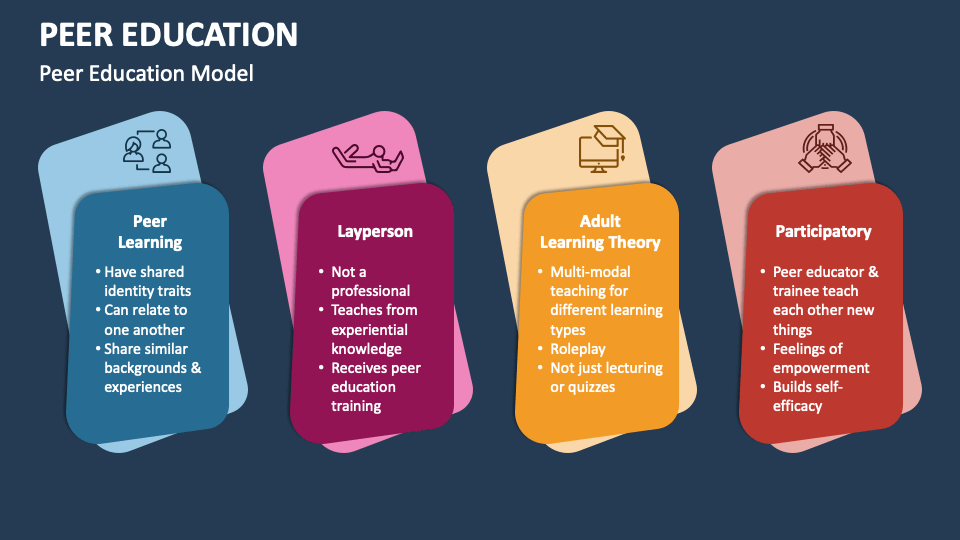The Core Principles of Peer Education:

At the heart of peer education lies the principle of shared understanding. Peers, having navigated similar life experiences and challenges, possess a unique ability to relate to and engage with one another in a way that traditional authority figures may not. This shared ground facilitates:
- Increased attention and participation: Students are more likely to listen to and engage with information presented by their peers, creating a more relaxed and receptive learning environment.
- Enhanced comprehension and retention: Explaining concepts to others solidifies understanding for both the teacher and the learner. The process of peer-to-peer teaching promotes active learning and fosters deeper cognitive engagement.
- Improved communication and interpersonal skills: Peer educators gain confidence in their communication and presentation abilities while developing empathy and active listening skills through interaction with their peers.
- Reduced stigma and increased accessibility: Sensitive topics, such as mental health, substance abuse, or sexual health, are often met with apprehension in traditional educational settings. Peer educators, by sharing their own experiences and vulnerabilities, create a safe space for open and honest conversations, breaking down barriers and reducing stigma.
- Increased sense of ownership and responsibility: By actively participating in their education, learners develop a sense of ownership and responsibility for their learning process and well-being.
Diverse Models of Peer Education:
The effectiveness of peer education stems from its adaptability to various contexts and disciplinary fields. Numerous models have been developed, each with its unique strengths and applications:
- Peer Tutoring:
This model focuses on providing academic support by pairing more advanced students with those who require assistance. Tutors can offer personalized guidance, clarify concepts, and facilitate group study sessions.
- Peer Mentoring:
Mentoring extends beyond academic support to encompass broader personal and professional development. Mentors, often with more experience in a particular field, guide mentees through challenges, offer advice, and provide encouragement.
- Peer Facilitation:
In this model, peers facilitate group discussions, lead workshops, and guide activities. This fosters active participation, encourages diverse perspectives, and empowers individuals to take ownership of their learning.
- Peer Health Education:
Peers are trained to deliver accurate information and support on health-related topics such as sexual health, substance abuse, stress management, and disease prevention. They act as trusted sources within their communities, promoting healthy behaviors and reducing health disparities.
- Cross-Cultural Peer Education:
This model utilizes the unique experiences and perspectives of individuals from different cultures to bridge cultural divides and promote understanding. Peers can facilitate dialogue, share cultural norms, and combat prejudices.
Factors Contributing to Effective Peer Education:
While the principles of peer education are universally applicable, several factors contribute to its successful implementation:
Careful selection and training of peer educators:
Choosing individuals who are knowledgeable, empathetic, and possess strong communication skills is crucial. Comprehensive training programs equip them with the necessary skills and resources to effectively deliver information and support their peers.
- Clear learning objectives: Defining specific learning outcomes ensures that the peer education program remains focused and impactful.
- Tailored content and delivery strategies: Content should be relevant to the target audience and delivered in a culturally sensitive and engaging manner.
- Supportive environment: Creating a safe space where peers feel comfortable sharing their experiences and asking questions is essential for fostering open communication and meaningful interaction.
- Ongoing evaluation and improvement: Regularly assessing program effectiveness and incorporating feedback allows for continuous improvement and optimization.
Frequently Asked Questions (FAQ):
- Can anyone be a peer educator?
Not necessarily. While everyone can learn from peers, effective peer educators possess particular qualities such as strong communication skills, empathy, and a genuine desire to help others. They typically undergo training to develop the necessary skills and knowledge.
- Is peer education effective?
Numerous studies demonstrate the effectiveness of peer education in various contexts. It has been shown to improve academic performance, promote healthy behaviors, increase empathy and reduce stigma, and empower individuals within communities.
- What are the limitations of peer education?
While peer education offers numerous benefits, it’s important to acknowledge potential limitations. Peer educators may lack expertise in certain areas, and their own biases can potentially influence the information they share. Over-reliance on peers for support may also prevent individuals from seeking professional help when needed.
- How can I implement peer education in my community?
Identifying the specific needs of your community, recruiting and training qualified peer educators, developing appropriate content, and establishing a supportive environment are crucial steps.
Conclusion:
Peer education holds immense potential to empower individuals and communities. By leveraging the strengths of shared experiences and interconnectedness, it fosters active learning, promotes healthy behaviors, and breaks down barriers to access and information. As we move towards more inclusive and collaborative educational approaches, embracing the power of peers will be crucial in creating a more equitable and empowered society.
Closure
Thus, we hope this article has provided valuable insights into Peer education models. We hope you find this article informative and beneficial. See you in our next article!